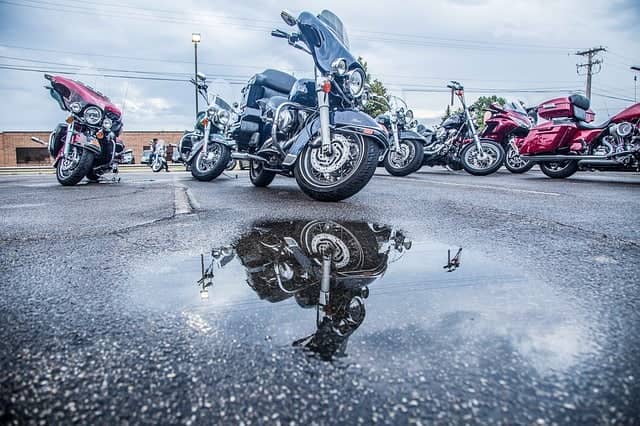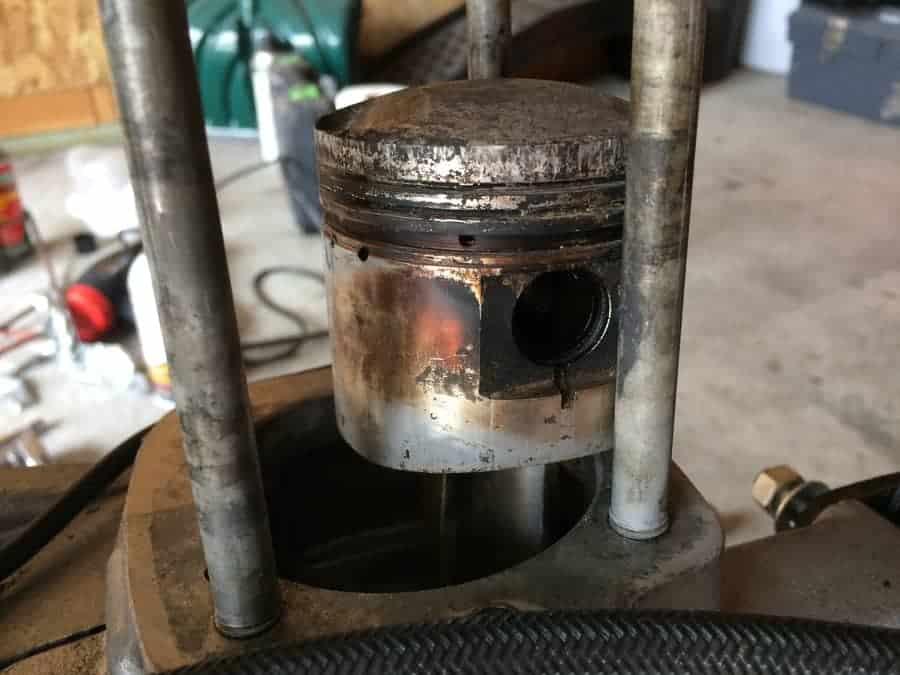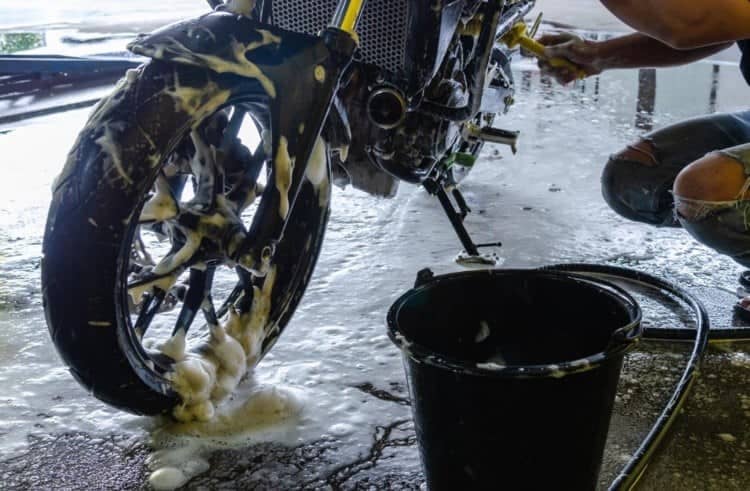
I’ve had several instances when I’ve been riding my motorcycle and was caught in a rain storm. Other times I forgot to bring my motorcycle in the garage and left it in the driveway with no cover during a rain or snow storm. A lot of people worry about their motorcycle’s health when it gets wet like that.
Is it OK for a motorcycle to get wet? Most motorcycles were designed to get wet. It is okay for it to be rained on whether in the driveway or while you’re riding it. However, excessive exposure to water can eventually cause damage to your motorcycle.
If you’re a frequent rider, it’s inevitable you’ll get caught in inclement weather. While a good water rinse doesn’t cause damage, there are things to think about when your motorcycle gets caught in the rain and/or snow.
What Could Happen To Your Motorcycle After Long Exposure To Water
Occasional exposure to water won’t cause damage to a motorcycle. People often ask what potential damage water can do to a motorcycle over time. Keep in mind that it would take a considerable amount of time for water to start damaging your motorcycle.
If left out for too long, meaning several months with no cover in excessive rain storms, you motorcycle will begin to have problems. Though motorcycles were made to get wet, water has the potential to still damage some parts of it.
Water will be able to find it’s way into your carbs and into your engine. Once it gets inside of your engine, you may have a difficult time starting your motorcycle. Water may mix with the oil inside your engine and will require an oil change.
One motorcycle I bought had been sitting for so long and had so much water in the engine that mold had actually grown inside! There was big nasty chunks of green and brown growth that I had to flush out while doing the engine rebuild.

Once water gets inside of metal parts, rust becomes a major concern. Rust can cause an engine to seize. Though that’s fixable, it’s still a headache. Water will also collect any dirt or grime that passes through which will create “gunk.” You’ll probably need to rebuild your carbs and do a thorough clean up.
Water can also eventually break down the lubrication of your chain if you have one. It’s dangerous to ride a motorcycle without a properly lubricated chain, so its important to have routine check-ups. If you’re worried about your chain lacking lubrication, go ahead and lube it.
Water may also find it’s way into your motorcycle tank and in the fuel lines. Your motorcycle will not run off of gas that’s mixed with water, in fact this can be incredibly dangerous to have ANY water in your gas tank.
If water gets into the combustion chamber and the gas ignites, those water molecules will flash off (boil); when water boils, it expands by a huge amount. This huge pressure jump can crack pistons and seize engines. So If your motorcycle has been sitting out in the rain for months at a time with no rides in between, expect to empty and refill your gas tank.
There are a few practices you can start now to ensure your motorcycle doesn’t get any damage from water exposure. Keep it inside a garage or shed any time you’re not riding it. If you don’t have either of those, purchase a quality cover for your motorcycle to keep out any water (see my recommended motorcycle cover here).
Do an occasional visual inspection of your motorcycle. If you notice any rust, sand and paint that particular spot to prevent the rust from spreading further.
What About Getting Your Motorcycle Wet While Washing It?

It is perfectly safe to wash your motorcycle and not cause any damage to it. Washing a motorcycle entails short-term water exposure and it is actually recommended to routinely do. However, there is a process that must be followed in order to prevent that water from damaging your motorcycle.
Before getting your motorcycle wet, ensure that the exhaust holes are plugged up some how. Usually stuffing a washcloth inside temporarily will do the job. If you have pod filters, cover them up with a plastic bag or remove them altogether and plug the intake holes. There’s no need to remove the air box and/or air filters; these should do a good job at keeping the water out as is. Do not skip these steps; while it is unlikely that water getting in these holes will cause damage, if damage is going to be done, it will be through these holes.
Once these hole are covered, you’re ready to wash your motorcycle. Use a hose (not a pressure washer) to get it wet and use soft fiber cloth to hand wash it. After you’re done cleaning it, dry it as best as you can. Let the motorcycle sit for an hour or so to completely dry before taking out the cloth you put in the exhaust and intake holes. Be sure to lubricate the chain if you have one.
Is It Bad For Your Motorcycle To Ride It In The Rain?
People are also often worried about riding their motorcycle in the rain, especially getting caught in an unexpected rain storm. If it hasn’t happened to you, chances are it’ll happen eventually.
Though riding your motorcycle in a rain storm isn’t the most ideal situation to be in, it isn’t necessarily dangerous, nor is it bad for your motorcycle. The most dangerous part about riding in the rain is the risk of hydroplaning.
Hydroplaning is when a tire or set of tires loses traction on the road due to water and ends up sliding or drifting. If you’re taking good care of your motorcycle and don’t have bald tires, you should be fine. Remember to slow way down during snow or rain. Motorcycles weigh so little, so hydroplaning can happen easier on a motorcycle than in a car. For more information on hydroplaning on a motorcycle, see my article here.
We had mentioned that water getting in the exhaust and intake holes can potentially cause damage. Keep in mind that when a motorcycle is running, it’s essentially impossible for water to get in through the exhaust since it’s so hot and would evaporate the water. Food filters should also keep the water from entering the intake.
How To Ride A Motorcycle In The Rain
Being prepared for a rainstorm while riding your motorcycle will greatly decrease your chances of an accident. It’s easy to disregard caution while it’s wet, but that idea is what causes motorcycle accidents.
Attempt to ride on the driest part of your lane. Every road is different, so look for puddles and low spots and stay away. I tend to get in the slow lane and put on my emergency flashers. A lot of motorcycles don’t have emergency flashers, in that scenario I just switch my blinkers back and forth so it catches people’s attention. The greatest risk in a rainstorm isn’t the rain, it’s other drivers not paying attention.
Avoid driving over any paint on the road. This includes the yellow and white lines and symbols. This paint is incredibly slippery and is perfect to make a motorcycle slide.
Avoid driving through puddles if possible. This will increase your chances of hydroplaning especially if you’re riding at higher speeds. You also don’t know what’s beneath the puddle; it could possibly be a pot hole. If you are unable to avoid it, slow down as much as possible and proceed with caution.
If you’re riding your motorcycle while it’s dry and it begins to rain, be extra cautious and slow down. The beginning of a rain storm causes a new mixture with all the oil and dirt on the road which makes it extra slick. Avoid any rainbow colored puddles as that is a sign of mixed oil.
Give more distance between you and other vehicles. Plan on breaking a lot sooner than you would when it’s dry. Water gets up into the braking system and can cause a delay with your motorcycle’s brake reaction.
To increase visibility, always keep your headlight on during a rain storm, even if it’s still light outside. Rain hinders other driver’s ability to see motorcyclists; your head light can alert other divers that you are present as well as help you see better.
Related Questions
How tall do you need to be to ride a motorcycle? To safely ride a motorcycle, you need to be able to mount the motorcycle without assistance. You should be able to touch the ground with your toes and the balls of your feet on both sides. For more information, see my article here.
Do I need to use hand signals when I ride a motorcycle? It is not required to use hand signals while you ride a motorcycle, especially if all your lights and blinkers are working. However, it’s good to be aware of the basic signs in case your lights go out.
